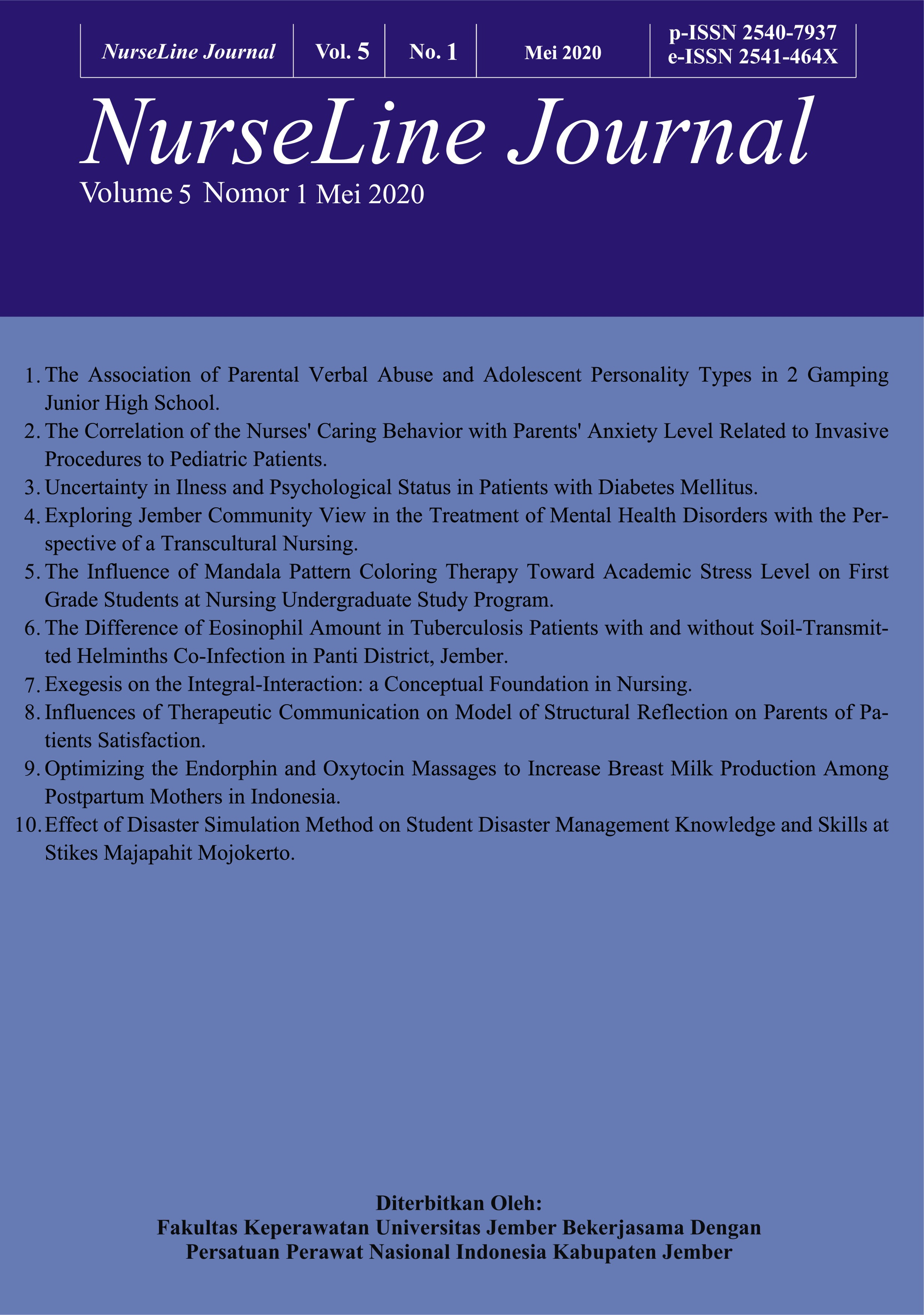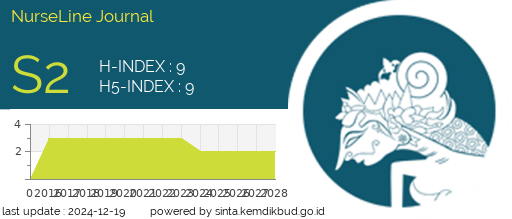Optimizing the Endorphin and Oxytocin Massage to Increase Breast Milk Production among Postpartum Mother in Indonesia
Optimizing the Endorphin and Oxytocin Massage to Increase Breast Milk Production among Postpartum Mother in Indonesia
DOI:
https://doi.org/10.19184/nlj.v5i1.16825Keywords:
endorphin massage, oxytocin massage, exclusive Breasfeeding, primiparous postpartum women., Breast Milk Production, Postpartum MotherAbstract
Exclusive breastfeeding is the gold standard of infant feeding in the first six months of their life. In Indonesia, breastfeeding practice has become a social norm among women. However, some women have experienced inadequate breast milk production especially in the first and second days after birth. This study aimed to investigate the effect of endorphin and oxytocin massage on breast milk production among primiparous postpartum women and their baby weight. a quasi-experimental design was utilized with pre-test and post-test control group design. The population in this study were 175 postpartum mothers in Lawang Primary Health Care Indonesia. Forty postpartum mothers were selected and allocated to the intervention and control groups. Ten women were received endorphin massage, ten were given oxytocin massage, ten mothers were received the combination of endorphin and oxytocin massage and the remaining ten were allocated into the control group. The dependent variables were breast milk production and infant body weight, whereases the independent variables were endorphin massage, oxytocin massage and combination of endorphin and oxytocin massages. Data were analyzed by using t-test followed by One Way ANOVA Test with α = 0.05. The results indicated differences between the four group regarding the breast milk production and an increase in baby weight with p = 0, 00<α = 0, 05 and p = 0.046 <α = 0.05 respectively. According to the results, the combination of endorphin and oxytocin massage is the most effective technique to increase breast milk production among postpartum women and therefore, facilitating the baby weight gain in the first six months of their life.
Downloads
References
Bowles, B. C. Breast Massage: A “Handy†Multipurpose Tool to Promote Breastfeeding Success. Clin Lactation(4), 21-24. doi: 10.1891/215805311807011575
Budiharjo, N. S. D. (2003). Masalah-masalah dalam menyusui. Jakarta: Perkumpulan Perinatologi Indonesia.
Castellote, C., Casillas, R., RamÃrez-Santana, C., Pérez-Cano, F. J., Castell, M., Moretones, M. G., . . . Franch, À. (2011). Premature Delivery Influences the Immunological Composition of Colostrum and Transitional and Mature Human Milk. The Journal of Nutrition, 141(6), 1181-1187. doi: 10.3945/jn.110.133652
Jahani shoorab, N., Mirteimouri, M., Taghipour, A., & Latifnejad Roudsari, R. (2019). Women’s Experiences of Emotional Recovery from Childbirth-Related Perineal Trauma: A Qualitative Content analysis. International Journal of Community Based Nursing & Midwifery, 7(3), 181-191. doi: 10.30476/ijcbnm.2019.44993
Kementerian Kesehatan Republik Indonesia, K. R. (2014). Profil Kesehatan Indonesia 2014. from http://www.depkes.go.id/
Kent, J. C., Prime, D. K., & Garbin, C. P. (2012). Principles for Maintaining or Increasing Breast Milk Production. Journal of Obstetric, Gynecologic & Neonatal Nursing, 41(1), 114-121. doi: 10.1111/j.1552-6909.2011.01313.x
Lu, P., Ye, Z.-Q., Qiu, J., Wang, X.-Y., & Zheng, J.-J. (2019). Acupoint-tuina therapy promotes lactation in postpartum women with insufficient milk production who underwent caesarean sections. Medicine, 98(35), e16456-e16456. doi: 10.1097/MD.0000000000016456
Moberg, K. U., & Prime, D. K. (2013). Oxytocin effects in mothers and infants
during breastfeeding. Infant, 9(6).
Nurmiati, & Besral. (2008). Pengaruh Durasi Pemberian ASI Terhadap Ketahanan Hidup Bayi di Indonesia. Makara, Kesehatan, 12(2), 47-52.
Ozalkaya, E., Aslandogdu, Z., Ozkoral, A., Topcuoglu, S., & Karatekin, G. (2018). Effect of a galactagogue herbal tea on breast milk production and prolactin secretion by mothers of preterm babies. Niger J Clin Pract, 21(1), 38-42. doi: 10.4103/1119-3077.224788
Saldan, P. C., Venancio, S. I., Saldiva, S. R. D. M., Vieira, D. G., & Mello, D. F. d. (2017). Milk Consumption in Infants under One Year of Age and Variables Associated with Non-Maternal Milk Consumption. [Consumo de leites em menores de um ano de idade e variÃveis associadas ao consumo de leite nÃo materno]. Revista paulista de pediatria : orgao oficial da Sociedade de Pediatria de Sao Paulo, 35(4), 407-414. doi: 10.1590/1984-0462/;2017;35;4;00004
Sari, N., Soejoenoes, A., Wahyuni, S., Setiani, O., & Anwar, C. (2017). The Effectiveness of Combination of Oxytocin and Endorphin Massage On Uterine Involution in Primiparaous Mothers. Belitung Nursing Journal, 3(5). doi: https://doi.org/10.33546/bnj.193
Saudia, B. E. P., & Murni, N. N. A. (2017). Pengaruh Endorphin Massage terhadap Peningkatan Produksi ASI pada Ibu yang terdeteksi Postpartum Blues dengan Skrining EPDS (Edinburg Postpartum Depression Scale) Di Puskesmas Wilayah Kerja Sekota Mataram. Journal Kesehatan Prima, 11(1), 36-42.
Widia;, L., & Meihartati;, T. (2018). Oxytocin Massage Enhanced Breast Milk Production in Postpartum Women. e-Journal Unair.
Yaqub, A., & Gul, S. (2013). Reasons for failure of exclusive breastfeeding in children less than six months of age. J Ayub Med Coll Abbottabad, 25(1-2), 165-167.











